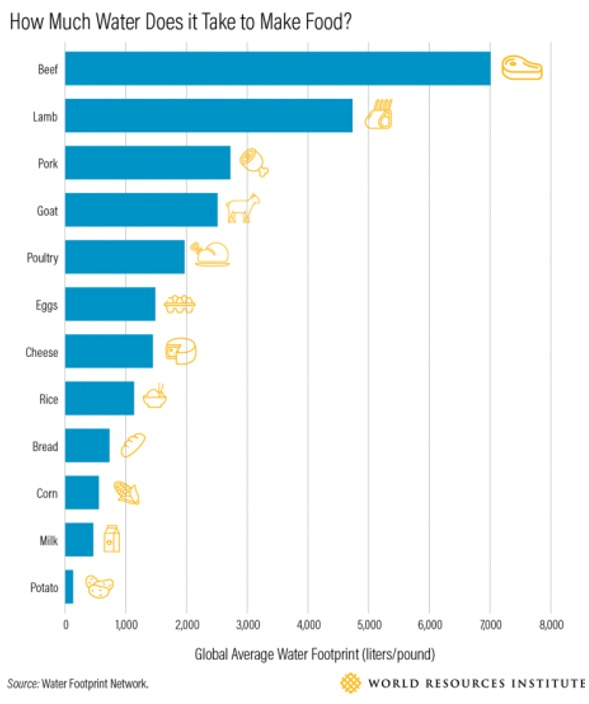May 29, 2024
Water Requirements for the Production of Common Food Products
Every day, each of us generally consumes about 100 gallons of water for our basic needs of drinking, bathing, cooking, toiletries, etc. (USGS, 2019; Kobir, 2024; and Philadelphia City Government, 2024). The United States Geological Survey (USGS) estimates that the average American needs 80-100 gallons per day for basic use and consumption (indoor use). The Arizona Department of Water Resources (ADWR) estimates that Arizonans consume an average of 146 gallons of water per day (ADWR, 2024).
As discussed in a recent article in this newsletter (Silvertooth, 2024) the water required to produce the food supporting an average Arizonan can range from 800 to 1,500 gallons per day. Thus, we can use an estimate of 1,000 gallons consumed per day to support our individual food requirements (Anyabwile and Walker, 2019; Wheeler, 2022; Food Print, 2024; Michel, 2023; Smith, 2012).
If this estimate of “virtual water” use is expanded to include clothing, appliances, vehicles, and other items in our common daily use the average water footprint for Americans easily comes up to 2,000 gallons of water per day (ASPE, 2022).
Looking at this more closely, we can see quite a wide range of water requirements to produce some common food items (Figure 1). It is interesting to note the increasing water requirements associated with meat products and that beef is commonly found at the top of the list.

Figure 1. Water requirements to produce some common food
items. Source: World resources institute, Anyabwile and Walker, 2019.
Considering daily indoor use and diet, a person can develop estimates on their own personal daily water consumption and water footprint by use of one of the water footprint calculators available on-line (i.e., Water Footprint Calculator).
Some good examples of water requirements (footprint) for basic food and daily use products include the following (Wade, 2024):
- One cup of coffee is estimated to be around 37 gallons.
- It takes about 365 gallons of water to make Spaghetti sauce with ground beef, garlic, oregano, onion, and basil according to the USDA.
- Sixty-five gallons of water are needed to produce a serving of rice and beans.
- The fruit in a fruit medley requires 71 gallons of water.
- It takes a total of almost 3,200 gallons of water to produce a mobile phone that includes numerous water-intensive stages, from mining rare minerals to assembling electronic components.
- A substantial amount of water is needed to provide the ongoing charging required for electric vehicles. This includes all the steps from the mining of lithium for batteries to manufacturing vehicle components.
- Approximately 13,700 to 22,000 gallons of water is required to produce each of our standard vehicles.
- The data centers that support the extensive digital landscape we navigate daily require huge amounts of water for cooling systems and infrastructure maintenance. For every 200 gigabytes of internet access approximately 40 gallons of water is needed, or about one-fifth of a gallon per gigabyte is required.
- A plastic water bottle requires twice as much water to produce the plastic than the volume of water in the bottle.
- One gallon of gasoline requires up to 2.5 gallons of water to refine it.
- One pair of leather shoes requires more than 2,100 gallons of water to produce.
The important point to consider is that we all use more water every day than is commonly realized. Water is essential to support all life and it takes a lot of water to grow plants and support animals that everyone needs to live and survive.
There is a strong demand for the food products shown in Figure 1 and all other food products as well. As consumers, we are all the direct beneficiaries of the water used to produce the crops with all the fruits and vegetables that come from them. Healthy animals require good food, which all comes from plants, i.e., alfalfa. Everything we consume has a significant water footprint.
We commonly devour our way through tons of good food while being totally oblivious to the reality of what it takes to put it all in the markets and ultimately on our kitchen tables. It is good for us to recognize the realities of the water requirements that support the production and provision of our food, particularly in these times of water shortages.
References:
Anyabwile, A. and S. Walker. 2019. 5 Ways to put food on a water diet. World Resources Institute. https://www.wri.org/insights/5-ways-put-food-water-diet
Arizona Department of Water Resources. 2019. Water Your Facts. Arizona Water Facts. https://www.arizonawaterfacts.com/water-your-facts
Arizona Department of Water Resources (ADWR). 2024. Conservation. https://www.azwater.gov/conservation/public-resources
ASPE. 2022. New research shows most Americans are unaware of their daily water consumption. ASPE Pipeline. https://aspe.org/pipeline/new-research-shows-most-americans-are-unaware-of-their-daily-water-consumption/#:~:text=Most%20believe%20they%20use%20less%20than%20100%20gallons,indirectly%20%28e.g.%2C%20the%20water%20required%20to%20produce%20food%29.
Food Print. 2024. The Water Footprint of Food. https://foodprint.org/issues/the-water-footprint-of-food/
Kobir. 2024. How many gallons of fresh water do we use per day. https://medium.com/rocklinca/how-many-gallons-of-freshwater-do-we-use-per-day-7987edf6b1bb
Michel, D. 2023. Water and Food: How, When, and Why Water Imperils Global Food Security. Center for Strategic and International Studies. https://www.csis.org/analysis/water-and-food-how-when-and-why-water-imperils-global-food-security
Philadelphia City Government. 2024. Gallons Used Per Person Per Day. https://water.phila.gov/pool/files/home-water-use-ig5.pdf
Smith, T. 2012. World Water Day: How much water do you use in a day? Climate Home News. https://www.climatechangenews.com/2012/03/22/world-water-day-how-much-water-do-you-use-in-a-day/
United States Geological Survey. 2019. How much water do I use at home each day? https://www.usgs.gov/special-topics/water-science-school/science/water-qa-how-much-water-do-i-use-home-each-day
Wade, M. 2024. Where does our water wind up? Ag Alert, California Farm Bureau Federation. 7 February 2024.
Water Footprint Calculator. 2024. https://watercalculator.org/water-footprint-of-food-guide/
Wheeler, M. 2022. Did You Know’ Series: How Much Water Are We Actually Using? Virginia Water Resources Research Center, Virginia Tech University. https://www.vwrrc.vt.edu/2022/03/31/did-you-know-series-how-much-water-are-we-actually-using/
To contact Jeff Silvertooth go to:
silver@ag.arizona.edu














